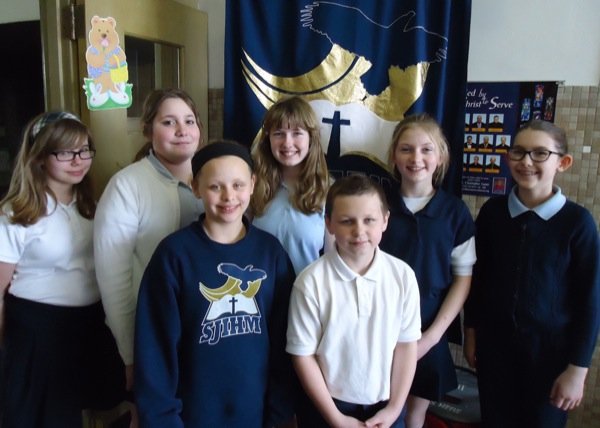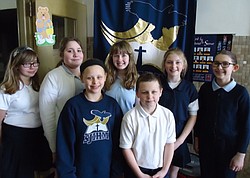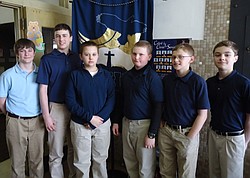SJIHM students do well at YSU Science Day

Neighbors | Submitted.From left, sixth-grade students at St. Joseph and Immaculate Heart of Mary School who won at the Youngstown State University Science Day were Isabelle Gasior, Julianna Frengler, Allyson Smith, Grace Cripe, Nicholas Moliterno, Ella Siembieda and Riley Burke.
Neighbors | Submitted.From left, eighth-grade students at St. Joseph and Immaculate Heart of Mary School who won at Youngstown State University Science Day were Joshua Harker, Colin Faloon, Jack Chepke, Andrew Siembieda, Thomas Pitko and Ryan Kopcial.
By TIM CLEVELAND
On March 22, 13 students in grades 6 and 8 from St. Joseph and Immaculate Heart of Mary School participated in Youngstown State University’s Science Day, which was hosted at Stambaugh Stadium.
Sixth-graders winners from SJIHM were Riley Burke, Nick Moliterno, Isabelle Gasior, Julianna Frengler, Allyson Smith, Grace Cripe and Ella Siembieda. The eighth-grade winners were Joshua Harker, Colin Faloon, Jack Chepke, Andrew Siembieda, Thomas Pitko and Ryan Kopcial.
“The projects that the students came up with were quite impressive,” said science teacher Dana Vlock. “They were all reflective of the students’ interests as well as the science behind those interests. The topics for their projects ranged from dogs’ behaviors and toy preferences to grey water and caffeine’s effects in plants to whether truss or suspension bridges are stronger. The process for the students doing their projects started back in October with them choosing a topic they were interested in. Then from that point, adhering to a schedule, both the sixth- and eighth-grade science classes began their research and went step by step through the components needed for their projects. The whole time, from the day they selected their topics in October, the students had to keep a log book with all of their notes, research, experimentation, findings, results, etc. that dealt with their project. This led them to our school’s science fair on Feb. 11. Further adjustments and edits were made to their projects and reports, based upon their critiques from that event and therefore led to their participation in YSU’s Lake to River Science Day.”
Both Moliterno and Burke explained the process that went into making their respective projects.
“The process of my science fair project began with figuring out what I was interested in exploring, coming up with a hypothesis, research, buy materials for the experiment, and figure it out,” Moliterno said. “My project was on roller coaster physics so I had to build one and used pipe insolation for the track. I also used two marbles for the carts, one was five grams and another smaller marble weighing in at three grams. After reading and writing the first part of my report, we started with making the track, the hill, and a one and one half-foot loop. We raced the marbles down at different heights and reported the results when they finally finished the track. I quickly realized my hypothesis was incorrect but learned a lot about science being put into action and the scientific method.”
“In my project I tested what kinds of toys my dog would like first,” Burke said. “I tested a squeaky versus a non-squeaky toy, a long toy versus a short toy and a toy with food in it versus one with no food. The results showed my dog picked the squeaky toy all three trials and the food toy all three trials, but in the long versus short toy he picked long once, short once and was neutral once. Because this happened, I tested the long versus short toy with my dog again as well as with eight other dogs. It was quite a lot of work.”
Moliterno and Burke each said they learned different lessons from doing the projects.
“I learned a lot about science and how much fun it can be,” Moliterno said. “I also learned about the laws of physics like height and force and how mass works with them. I got to actually see how stored potential energy can change into kinetic energy as a roller coaster or a marble goes down a hill. It really was fun learning about the science behind something I love and how these facts work. I look forward to learning more about physics, roller coasters and how the two work together!”
“From my project I learned dog toy preference is important for saving your money,” Burke said. “Everyone wants to have a happy pet, but dog toys are very expensive. When I bought new toys for the nine dogs, I got one long and one short instead of 18 toys and a lot of money spent. Also, the size of a dog doesn’t take a role in toy choice.”
 43
43


